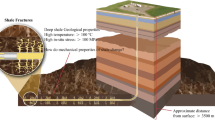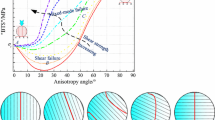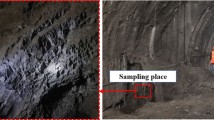Abstract
This paper presents a new thermal–mechanical coupled numerical approach to investigate the effects of temperature and inherent anisotropy on deep reservoir shale. The proposed method combines the discrete element method (DEM) with thermal expansion algorithm to capture the thermal behavior of deep reservoir shale. Anisotropic characteristics are reproduced by replacing linear parallel bonds dipping within a specific angle range with smooth-joint contacts. The effectiveness of the proposed coupled model is validated by comparing simulation results with experimental observations, focusing on the specimen responses and crack patterns. The modeling analysis shows that high confining stress conditions result in increased peak strength, elastic modulus, and residual strength. Conversely, high temperature treatment induces micro thermal damage, leading to a degradation of macro mechanical properties. Our numerical simulations suggest that shale exhibits ductile characteristics in high temperature and high pressure deep reservoir environment. To explore the applicability of the proposed approach, a parametric study is conducted to investigate micro parameters related to model anisotropy. Influence mechanisms and suggestions for parameter values are presented in detail. Finally, based on the constructed coupled approach, the thermal response of the model and corresponding particle-scale mechanisms are explored. The obtained conclusions could provide guidance for calibrating thermal-related parameters and offer theoretical explanations for DEM-based rock material simulations considering temperature effects.
Highlights
-
A thermal-mechanical coupled numerical model is proposed for deep shale reservoir.
-
Laboratory experiments under different conditions were performed for model validation and calibration.
-
Shale is expected to exhibit noticeable ductile characteristics under high temperature and high pressure conditions.
-
The proposed model is described and analyzed in detail to identify the micro factors influencing macro responses and explore the impact of environmental conditions.














Similar content being viewed by others
References
Alafnan S (2023) Mechanical alteration of the organic matters contained in shales through thermal treatment for an improved fracturing job: a molecular – Level investigation. Geoenergy Sci Eng 229:212046. https://doi.org/10.1016/j.geoen.2023.212046
Chong Z, Li X, Hou P, Wu Y, Zhang J, Chen T, Liang S (2017) Numerical investigation of bedding plane parameters of transversely isotropic shale. Rock Mech Rock Eng 50:1183–1204. https://doi.org/10.1007/s00603-016-1159-x
Closmann PJ, Bradley WB (1979) The effect of temperature on tensile and compressive strengths and young’s modulus of oil shale. Soc Pet Eng J 19:301–312. https://doi.org/10.2118/6734-PA
Coetzee CJ (2017) Review: calibration of the discrete element method. Powder Technol 310:104–142. https://doi.org/10.1016/j.powtec.2017.01.015
Cundall P, Potyondy D, Lee C (1996) Micromechanics-based models for fracture and breakout around the mine-by tunnel. In: Martino JB, Martin CD (eds) Proceedings, international conference on deep geological disposal of radioactive waste, Winnipeg. Canadian Nuclear Society, Toronto, pp 113–122
Cundall, P.A., Strack, O.D., 1979. A discrete numerical model for granular assemblies. geotechnique 29, 47–65.
Do HQ, Aragón AM, Schott DL (2018) A calibration framework for discrete element model parameters using genetic algorithms. Adv Powder Technol 29:1393–1403. https://doi.org/10.1016/j.apt.2018.03.001
Duan K, Kwok CY, Pierce M (2016) Discrete element method modeling of inherently anisotropic rocks under uniaxial compression loading: Simulation of Inherently Anisotropic Rock. Int J Numer Anal Methods Geomech 40:1150–1183. https://doi.org/10.1002/nag.2476
Espinoza WF, Zhang F, Dai S (2022) Impacts of temperature on the mechanical properties of Longmaxi shale outcrops using instrumented nanoindentation. Geomech Energy Environ 30:100348. https://doi.org/10.1016/j.gete.2022.100348
Estrada JM, Bhamidimarri R (2016) A review of the issues and treatment options for wastewater from shale gas extraction by hydraulic fracturing. Fuel 182:292–303. https://doi.org/10.1016/j.fuel.2016.05.051
Fan, Y., 2010. Numerical Simulation of the In-Situ Upgrading of Oil Shale. SPE J.
GCTS, 2022, n.d. https://mkn2cf.p3cdn1.secureserver.net/wp-content/uploads/2022/06/GCTS-Rock-Catalog-2022.pdf. GCTS-Rock-Cat.-2022. URL https://mkn2cf.p3cdn1.secureserver.net/wp-content/uploads/2022/06/GCTS-Rock-Catalog-2022.pdf
Gregory KB, Vidic RD, Dzombak DA (2011) Water Management Challenges Associated with the Production of Shale Gas by Hydraulic Fracturing. Elements 7:181–186. https://doi.org/10.2113/gselements.7.3.181
Guo Y, Huang L, Li X, Chen J, Sun J (2020) Experimental investigation on the effects of thermal treatment on the physical and mechanical properties of shale. J Nat Gas Sci Eng 82:103496. https://doi.org/10.1016/j.jngse.2020.103496
Hamdi P, Stead D, Elmo D (2014) Damage characterization during laboratory strength testing: A 3D-finite-discrete element approach. Comput Geotech 60:33–46. https://doi.org/10.1016/j.compgeo.2014.03.011
Han L, Li X, Liu Z, Guo W, Cui Y, Qian C, Huang Y (2023) Study on rock mechanics characteristics of deep shale in Luzhou block and the influence on reservoir fracturing. Energy Sci Eng 11:4–21. https://doi.org/10.1002/ese3.1360
Heng S, Li X, Liu X, Chen Y (2020) Experimental study on the mechanical properties of bedding planes in shale. J Nat Gas Sci Eng 76:103161. https://doi.org/10.1016/j.jngse.2020.103161
Kim KY, Zhuang L, Yang H, Kim H, Min K-B (2016) Strength Anisotropy of Berea Sandstone: Results of X-Ray Computed Tomography, Compression Tests, and Discrete Modeling. Rock Mech Rock Eng 49:1201–1210. https://doi.org/10.1007/s00603-015-0820-0
Labani MM, Rezaee R (2015) The Importance of Geochemical Parameters and Shale Composition on Rock Mechanical Properties of Gas Shale Reservoirs: a Case Study From the Kockatea Shale and Carynginia Formation From the Perth Basin. Western Australia Rock Mech Rock Eng 48:1249–1257. https://doi.org/10.1007/s00603-014-0617-6
Lemaitre J (1985) A Continuous Damage Mechanics Model for Ductile Fracture. J Eng Mater Technol 107:83–89. https://doi.org/10.1115/1.3225775
Lisjak A, Grasselli G, Vietor T (2014) Continuum–discontinuum analysis of failure mechanisms around unsupported circular excavations in anisotropic clay shales. Int J Rock Mech Min Sci 65:96–115. https://doi.org/10.1016/j.ijrmms.2013.10.006
Ma X (2019) Enrichment laws and scale effective development of shale gas in the southern Sichuan Basin. Nat Gas Ind B 6:240–249. https://doi.org/10.1016/j.ngib.2018.10.005
Ma Y, Huang H (2018) DEM analysis of failure mechanisms in the intact Brazilian test. Int J Rock Mech Min Sci 102:109–119. https://doi.org/10.1016/j.ijrmms.2017.11.010
Ma X, Wang H, Zhou S, Shi Z, Zhang L (2021) Deep shale gas in China: Geological characteristics and development strategies. Energy Rep 7:1903–1914. https://doi.org/10.1016/j.egyr.2021.03.043
Ma X, Zhang S, Zhang X, Liu J, Jin J, Cheng W, Jiang W, Zhang G, Chen Z, Zoback MD (2022) Lithology-controlled stress variations of Longmaxi shale – Example of an appraisal wellbore in the Changning area. Rock Mech Bull 1:100002. https://doi.org/10.1016/j.rockmb.2022.100002
Marigo, M., Stitt, E.H., 2015. Discrete Element Method (DEM) for Industrial Applications: Comments on Calibration and Validation for the Modelling of Cylindrical Pellets. KONA Powder Part. J. 32, 236–252. https://doi.org/10.14356/kona.2015016
Masri M, Sibai M, Shao JF, Mainguy M (2014) Experimental investigation of the effect of temperature on the mechanical behavior of Tournemire shale. Int J Rock Mech Min Sci 70:185–191. https://doi.org/10.1016/j.ijrmms.2014.05.007
Mbia EN, Fabricius IL, Krogsbøll A, Frykman P, Dalhoff F (2014) Permeability, compressibility and porosity of Jurassic shale from the Norwegian-Danish Basin. Pet Geosci 20:257–281. https://doi.org/10.1144/petgeo2013-035
Meng LB, Li TB, Jiang LW, Ma HM (2011) Experimental Study on the Influence of Temperature on Shale Mechanical Properties under Conventional Triaxial Compression. Adv Mater Res 250–253:1452–1455. https://doi.org/10.4028/www.scientific.net/AMR.250-253.1452
Mohamadi M, Wan RG (2016) Strength and post-peak response of Colorado shale at high pressure and temperature. Int J Rock Mech Min Sci 84:34–46. https://doi.org/10.1016/j.ijrmms.2015.12.012
Park B, Min K-B (2015) Bonded-particle discrete element modeling of mechanical behavior of transversely isotropic rock. Int J Rock Mech Min Sci 76:243–255. https://doi.org/10.1016/j.ijrmms.2015.03.014
Itasca, C.G.I., 2008. PFC3D—Particle Flow Code in 3 Dimensions, Version 4.0. Minneapolis.
Potyondy DO, Cundall PA (2004) A bonded-particle model for rock. Int J Rock Mech Min Sci 41:1329–1364. https://doi.org/10.1016/j.ijrmms.2004.09.011
Puttiwongrak, A., 2020. AN EASILY USED MATHEMATICAL MODEL OF POROSITY CHANGE WITH DEPTH AND GEOLOGIC TIME IN DEEP SHALE COMPACTION. Int. J. GEOMATE 19. https://doi.org/10.21660/2020.73.39179
Rybacki E, Herrmann J, Wirth R, Dresen G (2017) Creep of Posidonia Shale at Elevated Pressure and Temperature. Rock Mech Rock Eng 50:3121–3140. https://doi.org/10.1007/s00603-017-1295-y
Shi X, Kang S, Luo C, Wu W, Zhao S, Zhu D, Zhang H, Yang Y, Xiao Z, Li Y (2022) Shale gas exploration potential and reservoir conditions of the Longmaxi Formation in the Changning area, Sichuan Basin, SW China: Evidence from mud gas isotope logging. J Asian Earth Sci 233:105239. https://doi.org/10.1016/j.jseaes.2022.105239
Soeder DJ (2018) The successful development of gas and oil resources from shales in North America. J Pet Sci Eng 163:399–420. https://doi.org/10.1016/j.petrol.2017.12.084
Srinivasan V, Tripathy A, Gupta T, Singh TN (2020) An Investigation on the Influence of Thermal Damage on the Physical, Mechanical and Acoustic Behavior of Indian Gondwana Shale. Rock Mech Rock Eng 53:2865–2885. https://doi.org/10.1007/s00603-020-02087-2
Stanchits S, Vinciguerra S, Dresen G (2006) Ultrasonic Velocities, Acoustic Emission Characteristics and Crack Damage of Basalt and Granite. Pure Appl Geophys 163:975–994. https://doi.org/10.1007/s00024-006-0059-5
Tan J, Xie J, Li L, Lyu Q, Han J, Zhao Z (2020) Multifractal Analysis of Acoustic Emissions during Hydraulic Fracturing Experiments under Uniaxial Loading Conditions: A Niutitang Shale Example. Geofluids 2020:1–19. https://doi.org/10.1155/2020/8845292
Uffmann AK, Littke R, Rippen D (2012) Mineralogy and geochemistry of Mississippian and Lower Pennsylvanian Black Shales at the Northern Margin of the Variscan Mountain Belt (Germany and Belgium). Int J Coal Geol 103:92–108. https://doi.org/10.1016/j.coal.2012.08.001
Wang H, Ge Y, Shi L (2017) Technologies in deep and ultra-deep well drilling: Present status, challenges and future trend in the 13th Five-Year Plan period (2016–2020). Nat Gas Ind B 4:319–326. https://doi.org/10.1016/j.ngib.2017.09.001
Wang G, Yang D, Zhao Y, Kang Z, Zhao J, Huang X (2019) Experimental investigation on anisotropic permeability and its relationship with anisotropic thermal cracking of oil shale under high temperature and triaxial stress. Appl Therm Eng 146:718–725. https://doi.org/10.1016/j.applthermaleng.2018.10.005
Wong LNY, Zhang Y, Wu Z (2020) Rock strengthening or weakening upon heating in the mild temperature range? Eng Geol 272:105619. https://doi.org/10.1016/j.enggeo.2020.105619
Wu X, Li Y, Tang C (2023) Comparative study on heat extraction performance of three enhanced geothermal systems. Rock Mech Bull 2:100041. https://doi.org/10.1016/j.rockmb.2023.100041
Yang B, Jiao Y, Lei S (2006) A study on the effects of microparameters on macroproperties for specimens created by bonded particles. Eng Comput 23:607–631. https://doi.org/10.1108/02644400610680333
Yang S-Q, Ranjith PG, Jing H-W, Tian W-L, Ju Y (2017) An experimental investigation on thermal damage and failure mechanical behavior of granite after exposure to different high temperature treatments. Geothermics 65:180–197. https://doi.org/10.1016/j.geothermics.2016.09.008
Yang G, Liu J, Li X, Bi J (2020) Effect of temperature on shale strength under dynamic impact loading. Arab J Geosci 13:432. https://doi.org/10.1007/s12517-020-05435-2
Yang F, Chen S, Zheng K, Tian Y, He Q (2022) Study on the mechanism of mechanical property strengthening of Beishan granite under mild temperature condition. Case Stud Therm Eng 40:102554. https://doi.org/10.1016/j.csite.2022.102554
Ye Q, He X, Suo Y, Zhao S, Ai C, Qiao L, Song M, Chen X, Zhou X (2022) The Statistical Damage Constitutive Model of Longmaxi Shale under High Temperature and High Pressure. Lithosphere 2022:2503948. https://doi.org/10.2113/2022/2503948
Zhao J, Ren L, Shen C, Li Y (2018) Latest research progresses in network fracturing theories and technologies for shale gas reservoirs. Nat Gas Ind B 5:533–546. https://doi.org/10.1016/j.ngib.2018.03.007
Zhao P, Xie L, He B, Liu J (2020) Strategy Optimization on Industrial CO 2 Sequestration in the Depleted Wufeng-Longmaxi Formation Shale in the Northeastern Sichuan Basin, SW China: From the Perspective of Environment and Energy. ACS Sustain Chem Eng 8:11435–11445. https://doi.org/10.1021/acssuschemeng.0c04114
Zhao, F., 2019. Effects of pre-existing fissures on surface macro-crack characteristics of granite subjected to elevated temperatures. Acta Geodyn. Geomater. 441–450. https://doi.org/10.13168/AGG.2019.0037
Zhou X, Ghassemi A (2009) Finite element analysis of coupled chemo-poro-thermo-mechanical effects around a wellbore in swelling shale. Int J Rock Mech Min Sci 46:769–778. https://doi.org/10.1016/j.ijrmms.2008.11.009
Zhou H, Liu H, Hu D, Yang F, Lu J, Zhang F (2016) Anisotropies in Mechanical Behaviour, Thermal Expansion and P-Wave Velocity of Sandstone with Bedding Planes. Rock Mech Rock Eng 49:4497–4504. https://doi.org/10.1007/s00603-016-1016-y
Acknowledgements
The data of this study can be fully reached by contacting the coresponding author FZ.
Funding
This research is funded by the National Natural Science Foundation of China (42320104003, 42077247), the Fundamental Research Funds for the Central Universities and the Major Advanced and Basic Research Project of PetroChina (2021DJ4501, 2021DJ1805).
Author information
Authors and Affiliations
Corresponding author
Ethics declarations
Conflict of interest
The authors declare that they have no known competing financial interests or personal relationships that could have appeared to influence the work reported in this paper.
Additional information
Publisher's Note
Springer Nature remains neutral with regard to jurisdictional claims in published maps and institutional affiliations.
Rights and permissions
Springer Nature or its licensor (e.g. a society or other partner) holds exclusive rights to this article under a publishing agreement with the author(s) or other rightsholder(s); author self-archiving of the accepted manuscript version of this article is solely governed by the terms of such publishing agreement and applicable law.
About this article
Cite this article
Zhou, Z., Zhang, F., Fu, H. et al. A thermal–mechanical coupled DEM model for deep shale reservoir: the effects of temperature and anisotropy. Rock Mech Rock Eng 57, 3707–3726 (2024). https://doi.org/10.1007/s00603-023-03756-8
Received:
Accepted:
Published:
Issue Date:
DOI: https://doi.org/10.1007/s00603-023-03756-8




